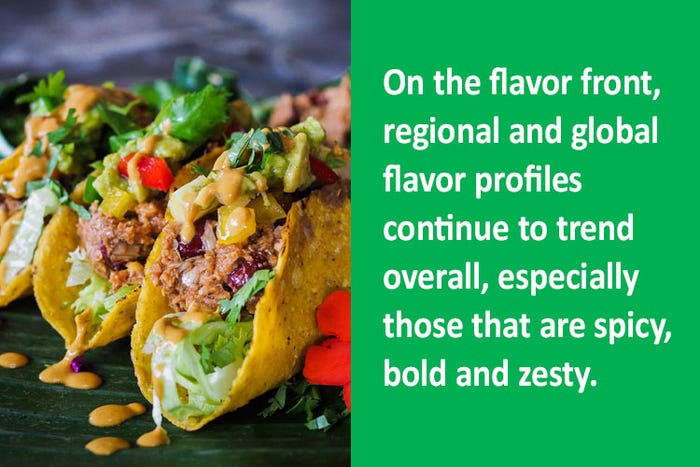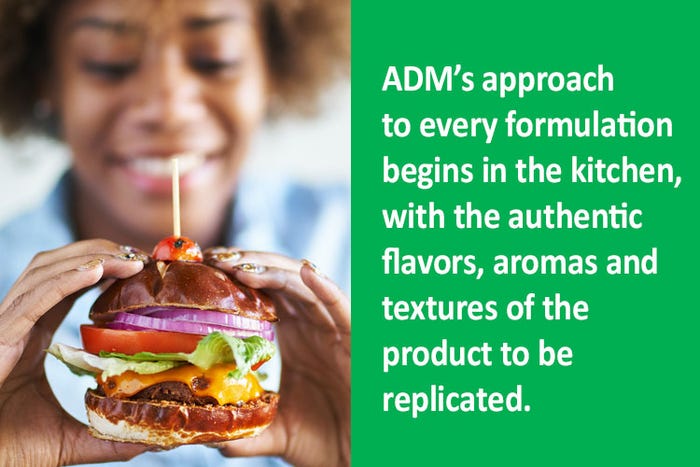Innovation in plant-based foods: Providing a superior eating experience
December 2, 2020

Sponsored by ADM
There’s no doubt about it: plant-based foods and beverages have gone mainstream, thanks to an ever-widening base of consumers that reaches beyond vegans and vegetarians. In fact, according to ADM research, while most flexitarian consumers are trying to increase their consumption of such products, 59% of them still eat meat and dairy. What this means for formulators is that the bar is higher than ever, as today’s largest segment of flexitarian consumers isn’t necessarily devout and will revert back to conventional versions of their favorite foods if alternatives aren’t just as good—or better.
Natural Products Insider says that nutrition and sustainability attributes still remain category drivers for plant-based products. In a nod to the category’s evolution, it also reports that culinary engagement, or the ability to get creative in the kitchen, is as important as ever[1]. Indeed, ADM research shows that taste is beginning to eclipse nutrition in importance: 63% of consumers place these qualities on equal footing, confirming that if a product doesn’t taste great, no amount of nutritional value will motivate repurchase.
At ADM, experts in culinary, flavor and sensory all work together to achieve culinary creations that keep conventional and flexitarian consumers alike coming back for more.

Solving taste and texture challenges
With stress and anxiety on the rise, Mintel reports that consumers are turning to comfort foods and classic dishes to improve their moods and transport them back to less stressful times in their lives[2]. In order for plant-based foods to compete in this environment, it’s critical that they overcome taste and texture challenges that have stunted their potential in the past. This includes addressing the bitter, earthy or beany flavors imparted by some plant proteins, and meeting expectations for juicier textures equivalent to those found in meat products.
“Replicating a dish isn’t about just one element—it’s about replicating the entire eating experience,” says ADM chief savory flavorist Ken Kraut. “We strive to make that experience authentic. The proteins, modulation aspects, umami and so much more must come together to deliver the desired finished product.”
At ADM, trends driving innovation in the meat-alternatives space include replicating the smell and sizzle of cooking bacon or wood fire cooking before consumers even take their first bite. On the flavor front, regional and global profiles continue to trend overall, especially those that are spicy, bold and zesty. In marinades, specifically, flavor trends include charred and smoky flavors featuring sweet and caramelized notes. Further enabling culinary flexibility is the emergence of powdered and liquid marinades formulated to work in concert with the center-of-plate plant protein and application process used.
Beyond flavor and texture, ADM research shows that consumers also expect plant-based foods (especially meat alternatives) to provide beneficial nutrients like high quality protein and a 'clean' label. The good news? Finding the right formulating partner is sometimes all it takes to meet these varying demands.

The ADM approach
At ADM, formulation for plant-based foods and beverages begins with the consumer and their gold standards for finished products across the board, from flavor and texture to color and aroma. Although the foundation of the product might begin with the right protein (or combination of various proteins), it doesn’t end there.
ADM’s Sensory & Consumer Insights team works closely with product developers to ensure that prominent taste and texture characteristics align with current trends, and that the product’s appeal reaches beyond vegans and vegetarians to flexitarians who eat meat and expect an authentic experience. Innovation surrounds staples like veggie burgers and red meat alternatives, but also includes seafood, chicken, pork and sausage alternatives, which each require a unique approach to flavor and texture technology and an expert development team to match.
Regardless of application, ADM’s approach to every formulation begins in the kitchen, with the authentic flavors, aromas and textures of the product to be replicated. “Demand for authenticity and closely resembling the real thing is much more prominent than in the past,” says Kraut. “Previously, developers were not necessarily trying to replicate real meat or regional flavors but doing so now has been instrumental to the growing success of the plant protein and meat alternative space.”

One of the newest approaches, further confirming the flexitarian as a changemaker, is blending animal and plant proteins together in the same product to reduce, rather than completely eliminate, meat. ADM has been able to formulate a blended animal- and plant-based chicken nugget with better-for-you positioning. It features a blend of 80% animal protein and 20% plant protein consisting of navy bean and carrot powder. ADM also reformulated chicken shawarma meatballs, with a half-and-half blend of chicken and plant-based protein, flavored with globally inspired spices. This approach helps brands formulate products that offer consumers a twist on the familiar, without pushing them too far out of their comfort zone.
In all, ADM’s Culinary Crafted Solutions help both plant-based and conventional brands meet taste, texture, nutrition, functionality and cost challenges with chef-driven recipes and on-trend product design and development. “We have the industry’s most comprehensive portfolio and a leading culinary team,” says Kraut. “The result is helping customers get to market faster with authentic, winning products.”
[1] “Plant-based revolution digital magazine.” Natural Products Insider. November 2019.
[2] https://www.mintel.com/blog/food-market-news/savoury-comfort-foods-for-uncertain-times
You May Also Like